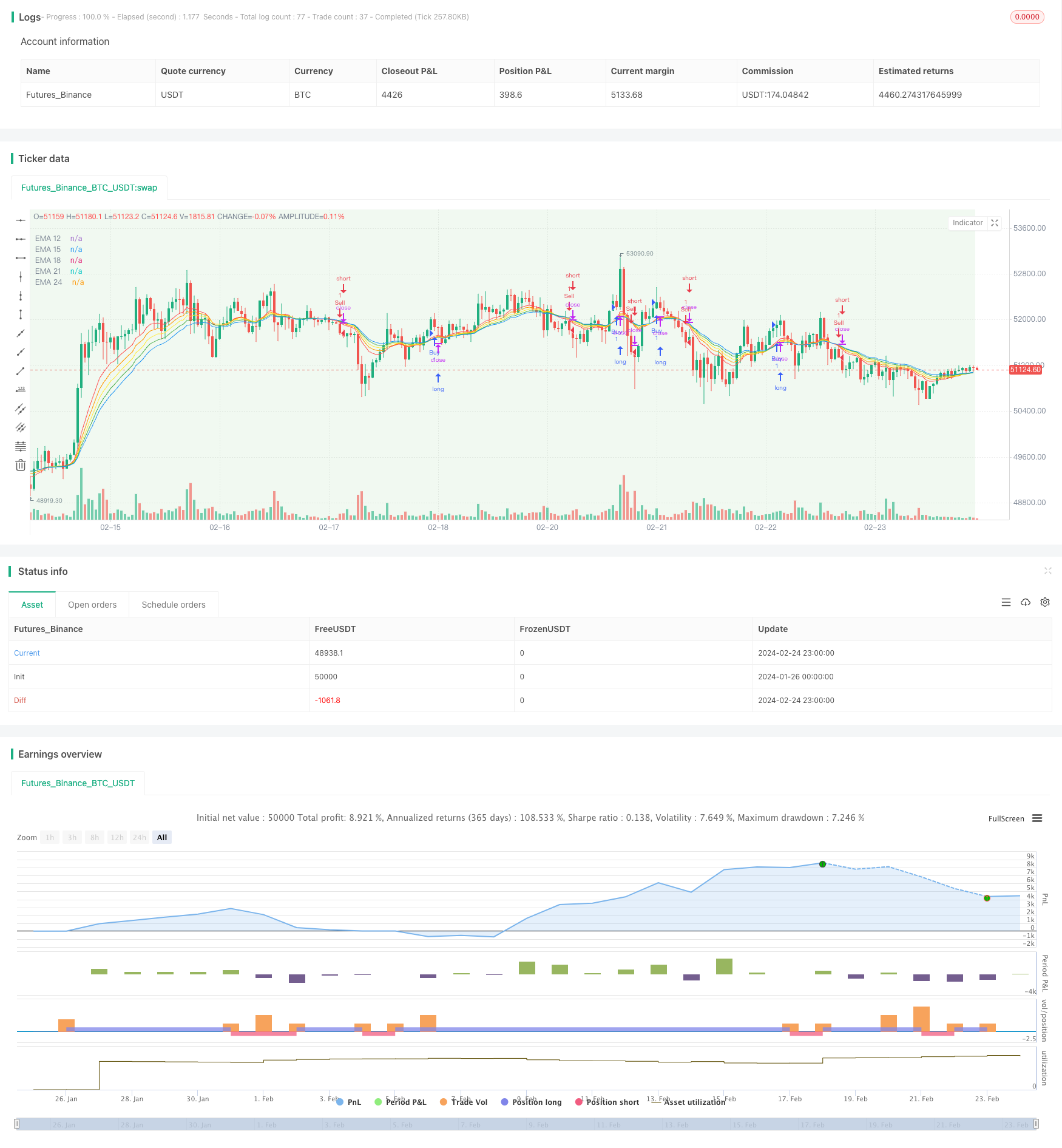
概述
该策略是一种基于多周期指数移动平均线(EMA)的趋势跟踪和顺势突破交易策略。它同时结合了5个不同周期的EMA,具有较强的趋势识别能力,可以顺势捕捉中长线价格运动。
策略原理
计算5个不同周期的EMA,具体为12周期、15周期、18周期、21周期和24周期的EMA。
EMA排序:EMA12 > EMA15 > EMA18 > EMA21 > EMA24 作为买入信号;EMA12 < EMA15 < EMA18 < EMA21 < EMA24 作为卖出信号。
只有在用户设定的起始日期之后,才会触发交易信号。
当触发买入信号时,执行长仓开仓操作;当触发卖出信号时,执行短仓开仓操作。
该策略通过组合多个EMA,形成一个趋势通道,利用通道内外轨的关系判断价格趋势方向。EMA周期设置比较接近,可以提高对突破信号的敏感性,同时也避免被短期市场噪音误导。此外,允许用户自定义策略的起始日期,可实现更大的灵活性。
优势分析
使用多组EMA形成趋势通道,识别趋势的能力较强。
EMA周期设置接近,对趋势突破信号灵敏,可及时捕捉中长线趋势。
可自定义策略起始日期,使用灵活。
资金管理可定制,可控制单笔订单规模。
交易规则清晰简单,适合趋势跟踪。
风险分析
EMA本质具有滞后性,可能错过短期剧烈波动。
突破交易容易被套,需要合理止损。
趋势反转时容易形成重大损失。
需要选择合适的股票品种,不适用于波动性过大的股票。
相应的风险控制和优化措施:
适当调整EMA参数,优化周期组合。
增加其他指标过滤,确定趋势方向。
合理设置止损点,控制单笔损失。
优化思路
增加其他指标组合,例如MACD、KDJ等,提高策略效果。
添加交易量的条件判断,避免虚假突破。
优化EMA的周期参数,寻找最佳组合。
在特定时间段停止交易,规避市场波动期。
采用机器学习方法动态优化EMA周期和参数。
总结
该策略总体而言是一个较为典型的趋势跟踪策略。它利用EMA的优点,通过组合多个EMA形成交易通道,当价格突破通道时产生交易信号。策略优点是交易规则简单清晰,容易跟踪中长线趋势;缺点是对短期市场噪音敏感,存在一定的滞后性。通过适当调整参数以及加入其他辅助工具的优化,可以提高策略稳定性和效果。它适合有一定交易经验的投资者使用。
/*backtest
start: 2024-01-26 00:00:00
end: 2024-02-25 00:00:00
period: 1h
basePeriod: 15m
exchanges: [{"eid":"Futures_Binance","currency":"BTC_USDT"}]
*/
//@version=5
strategy(title="Scalping Strategy - EMA",
shorttitle="EMA Scalp",
overlay=true)
// User input for start date
startDateInput = input(title="Start Date", defval=timestamp("2024-02-01"))
// Calculate EMAs
ema_12 = ta.ema(close, 12)
ema_15 = ta.ema(close, 15)
ema_18 = ta.ema(close, 18)
ema_21 = ta.ema(close, 21)
ema_24 = ta.ema(close, 24)
// Plot EMAs
plot(ema_12, color=color.red, title="EMA 12")
plot(ema_15, color=color.orange, title="EMA 15")
plot(ema_18, color=color.yellow, title="EMA 18")
plot(ema_21, color=color.green, title="EMA 21")
plot(ema_24, color=color.blue, title="EMA 24")
// Define a start date for the strategy based on user input
isAfterStartDate = true
// Visualize the isAfterStartDate condition
bgcolor(isAfterStartDate ? color.new(color.green, 90) : na, title="After Start Date")
// Entry conditions
buy_condition = (ema_12 > ema_15) and (ema_15 > ema_18) and (ema_18 > ema_21) and (ema_21 > ema_24) and isAfterStartDate
sell_condition = (ema_12 < ema_15) and (ema_15 < ema_18) and (ema_18 < ema_21) and (ema_21 < ema_24) and isAfterStartDate
// Execute trades using conditional blocks
if (buy_condition)
strategy.entry("Buy", strategy.long)
if (sell_condition)
strategy.entry("Sell", strategy.short)